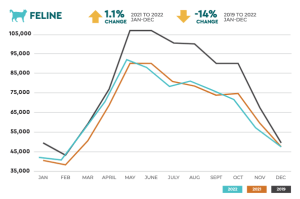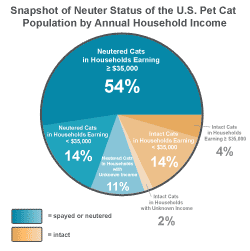
Shelters across the country are taking in kittens like crazy these days: singletons, litters, and mom-kitten groups; bottle-feeders, crawlers, and teens (11-19 weeks). Cats are seasonal breeders, which means that the hours of daylight influence their reproductive activity. When the solstice hits, they get going. When they get going, they reproduce a lot. The average litter is 4-6 kittens, with 1-2 litters per season. When these kittens don’t have any where else to go in our community, they end up at the shelter.

A study published in 2009 gave us some general demographic data about the cats that are able to procreate. The authors found that 98% of feral cats in the United States were not spayed or neutered, while only 7% of cats in homes with incomes greater than $75,000 per year were intact. It is estimated that the number of cats in homes is equal to or slightly more than the number of feral cats. Hopefully in the 15 or so years since this data was collected, we’ve improved both access to spay-neuter through programs like this, and have made some in-roads into controlling the feral population.
Given this information, it is not surprising that the major source of kittens coming into shelters in May through October are off-spring of feral moms or accidental litters born in the home. To help combat the summer avalanche of kittens, here are six strategies that you can employ if you encounter a kitten (or six.)
1) If you have a female cat, please get her spayed as soon as possible. The majority of shelters and spay-neuter clinics will perform this surgery even if she might be pregnant; please call your local veterinarian to find out what their policy might be. Keep her inside if she shows signs of being in heat (this is hard!). If wait times for spay-neuter are very long where you live or you just want to try birth control, talk to your veterinarian about whether megesterol acetate is a good option.
2) If your cat has given birth to kittens and you don’t have space for everyone or time to find them homes, keep mom and kittens safe and warm and at your home until they are eight weeks of age. Call the shelter you plan to surrender them to several weeks in advance. They might be able to hook you up with free deworming and vaccinations even before admission. Shelters spay and neuter kittens as early as eight weeks old, and surgery is usually required before adoption, so that’s the perfect time to bring them in and get them out.
3) If your cat has given birth to kittens and you can find them homes, excellent! Shelters are there to back you up if it doesn’t work out, but surely you know someone who needs a furry terrorist (or six) in their life?
4) If you find a nest of tiny kittens with closed ears or eyes on your property or public spaces, if at all possible leave them where they are. The feral or stray mother cat is the very best caretaker for those kittens, and she is the best chance they have for survival. She will be back as soon as you are gone. This is not the time to kidnap kittens; shelters need to reserve bottle-feeding foster parents for kittens who truly don’t have a mom.
5) If you find young mobile kittens with open eyes and ears, or if the kittens in (4) are now 4 weeks old, this is a decent time to intervene. Intervention should always include calling your local shelter in advance and setting a trap for the mother cat, so she can get spayed/neutered and put back. Otherwise you’ll just be in exactly the same situation 3-4 months from now. Call the shelter to coordinate your plans, to borrow traps, and to get advice on how to catch kittens.

6) Foster! If you have some extra hours, space in your home, and love in your heart, become a volunteer pet parent for your local shelter. These could be kittens you just found (see 5) or those brought to the shelter by someone else. SPCAs and Humane Societies often have well organized foster programs that offer training and support. Municipal shelters may have fewer resources, but may also need your help more than limited admission organizations. Either way, it’s a fantastic summer experience for the whole family, and a great way to give back to your community. There is nothing more precious than a cute, innocent kitten snoozing sweetly on your lap. Or six.
Lena DeTar is the interim director of the Maddie’s® Shelter Medicine Program at Cornell University’s College of Veterinary Medicine and the proud mom of dozens of foster kittens. She supports foster parents and spays feral cats at the Tompkins County SPCA in Ithaca, NY.

